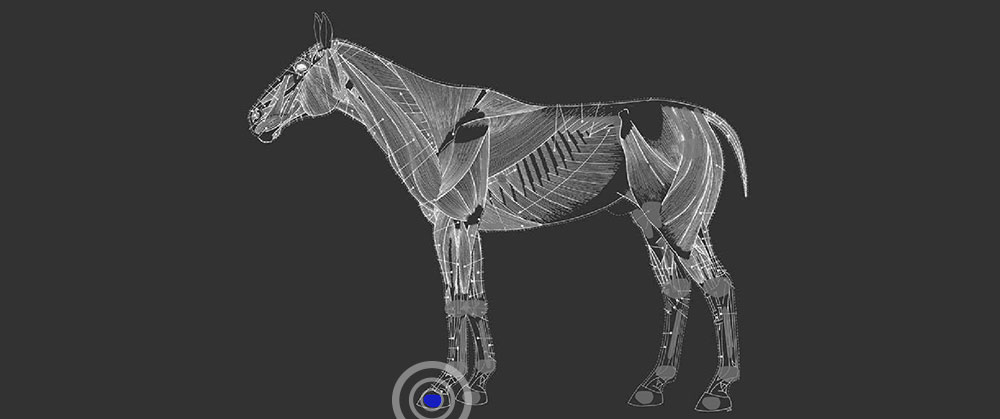Feet Pain
Feet Pain

Feet pain is the most common syndrome which I come across in my acupuncture work up. Whilst it is common, it is complex and has effects both in the feet and in many other areas of the body. Region such as the heal. frog, sole, wall and their internal structures such as coffin and navicular bones, ligaments, bursae, cartilages, tendons, joints, connective tissues are all supplied by nerves and can all exhibit pain. As explained above pain from these tissues is common and they have been an issue for horses well before domestication and shoeing. Sole and heal bruising and abscesses were all issues that the horse had to evolve and cope with, they therefore have developed a system of unconscious muscle guarding which would allow the horse to take pressure off the feet especially the heal region while resting as well as allowing the horse to stay on the move whilst dealing with the feet pain.
To reduce the feet/heal pain the horse contracts the deep digital flexor muscle for which it’s tendon inserts on the distal aspect of the coffin bone after passing over the navicular bone, this lifts the heal and relieves the pain in the foot, it’s also the cause of coffin bone rotation in laminitis.
In conjunction with the contraction of the deep digital flexor muscle is the assistance by the horse’s back in the psoas group of muscles. This muscle group contracts the ventral aspect of the lower thoracic, lumber and lumbo-sacral regions of the spine to help shift the weight. Because of this system there are many associated heal and lumbo-sacral issues which significantly effects the posture and movement of the horse. These changes put a increased amount of stress on the anterior forelimb such as the anterior coffin joint, fetlock and knees and the lumbo-sacral region of the of the horse’s back. The constant contracture of the psoas muscles weakens the lumbo-sacral and pelvic musculature which inhibits the power and drive from the hindquarters through the spine and thus limits performance.
The combination of the posterior forelimb and psoas contracture initiates regions of hypertonicity in the shoulder, muscles such as the lateral triceps, deltoid, pectoral and brachiocephalic are all effected. Therefore on inspection of a horse where the owner has complained of shoulder soreness it is more
common to find the cause of this soreness in the feet than primarily in the shoulder, Thus if treatment doesn’t resolve the feet pain then this shoulder soreness is unlikely to resolve.
As the feet pain persists a trigger point develops in the region of the girth in the body of the thoracic ventral serratus muscle, this point triggers local hypertonicity and in the surrounding pectoral muscles that causes the horse to become very reactive to palpation and to stress such as the girth on the saddle.
The typical action of a horse with chronic heel pain is a shortness in forelimb stride particularly the first few strides walking out of the box of a morning after standing still all night in the box, the horse usually improves with trotting and cantering as blood flow is pumped into the feet/heal region and it’s associated muscles and improves it’s flexibility and stretch.
Most structural issues causing pain need to be addressed by the farrier, either by giving more heal support or shortening the toe to reduce stress on the anterior aspect of the forelimbs.
The acupuncture work up is very effective in differentiating between feet pain with associated muscle hypertonicity and muscle injury of the shoulder and chest region. Proper treatment can then be initiated in which acupuncture can be of primary benefit to the feet and the shoulder and lumbo-sacral region.
- Acupuncture is used to restore the chi and blood stagnation locally which opens up capillaries in the feet (improves blood flow) which often close up with inflammation and with lack of blood flow.
- Acupuncture is beneficial in unlocking the pelvic and lumbo-sacral hypertonicity.
common to find the cause of this soreness in the feet than primarily in the shoulder, Thus if treatment doesn’t resolve the feet pain then this shoulder soreness is unlikely to resolve.

